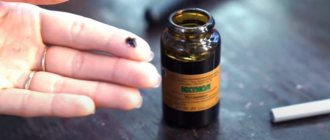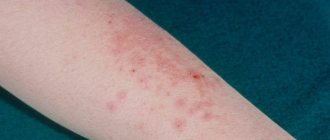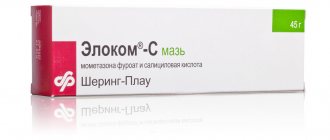Pharmacodynamics and pharmacokinetics
The active component of the drug, Flumethasone , is a synthetic bifluorinated corticosteroid intended for external use. The substance has anti-inflammatory , antiallergic , antipruritic , decongestant and vasoconstrictor effects. By acting on the skin, the drug helps prevent the marginal accumulation of neutrophils , reducing inflammatory exudate and the production of lymphokines, inhibits the migration of macrophages, reduces the processes of infiltration and granulation, and so on.
Clioquinol or iodochlorooxyquinoline is a derivative of 8-hydroxyquinolines. Its activity is manifested against yeast fungi, dermatophytes, and gram-positive bacteria. In addition, the antiexudative effect of Flumethasone .
The combined effect of Flumethasone and Clioquinol suppresses the development of various inflammatory and allergic reactions on skin surfaces, which can be complicated by bacterial or fungal infections.
Thanks to its fatty base, the ointment has a softening and water-repellent effect, which is provided by a protective film that protects the skin from moisture. This drug is suitable for use by patients with dry and thin skin.
After applying the product to the skin, its active substances penetrate the stratum corneum. In this case, flumethasone pivalate is not absorbed into the bloodstream and does not have a systemic effect. Increased absorption occurs as a result of frequent use of the ointment or its application to large areas of the skin. This can also be expected when using the product on the face, in skin folds, in places of damage to the epidermis, under an occlusive dressing. It should be noted that in children the effect of the substance is especially pronounced. Clioquinol in the ointment is absorbed through the skin, binding to blood plasma proteins.
The active substances are slightly metabolized in the skin structure. Mostly this process occurs in the liver. The components are then excreted from the body in urine or bile.
Pharmacodynamics
Due to flumethasone, it has a pronounced anti-inflammatory, antiallergic, and antipruritic effect. Reduces permeability and changes the structure of tissue and cell membranes, reduces the migration of macrophages and lymphocytes, affects all phases of inflammation, blocks the release of histamine and other biologically active substances from sensitized mast cells and basophils. The clioquinol contained in the composition causes antimicrobial activity (against most gram-positive and gram-negative bacteria and fungi), and also enhances the antiexudative effect of flumethasone.
Contraindications for use
This drug is not prescribed for:
- skin tuberculosis;
- viral skin lesions, such as chickenpox or herpes ;
- syphilis with manifestations on the skin;
- precancerous conditions and skin tumors;
- perioral dermatitis ;
- period after vaccination;
- acne;
- trophic ulcers caused by varicose veins ;
- under 10 years of age;
- hypersensitivity.
Directions for use and doses
Externally. The ointment is applied in a thin layer to the affected areas of the skin, at the beginning of treatment - 2-3 times a day, when positive dynamics appear - 1-2 times a day; Duration of use - no more than 2 weeks. If necessary, use a bandage that allows air to pass through. In case of excessive lichenification and hyperkeratosis - only under an occlusive dressing once every 24-48 hours, for no more than 1 week.
Unnecessarily, you should not use more than 2 g of ointment per day.
In adolescents over 10 years of age - only in exceptional cases, on limited areas of the skin, avoiding applying the drug to the skin of the face.
Side effects
The use of the drug Lorinden C can cause: burning, stretch marks, folliculitis , itching and dry skin. Long-term use leads to the development of: purpura, skin atrophy , telangiectasia, pigmentation disorders, local hirsutism . When the product is applied to large areas for a long time, side effects characteristic of GCS may occur.
Lorinden® A
The course of continuous therapy is no more than 2 weeks.
Avoid contact of Lorinden® A ointment with the eyes and mucous membranes. If, when using Lorinden® A ointment externally, there are signs of irritation, increased dry skin or allergies, as well as increased side effects or effects not specified in the instructions, you should stop treatment and consult a doctor.
With long-term use and/or application to large surfaces of the skin, wounds, damaged skin, the use of large doses, when using occlusive dressings and when treating children with Lorinden® A ointment, systemic absorption of glucocorticosteroid and salicylic acid is possible; it is possible to suppress the function of the hypothalamic-pituitary-adrenal system and develop symptoms of hypercortisolism.
During drug therapy, periodic monitoring of the function of the adrenal cortex is necessary by determining the concentration of cortisol in the blood and urine after stimulation of the adrenal glands with adrenocorticotropic hormone (ACTH).
In case of development of a secondary bacterial or fungal infection, it is necessary to prescribe external use of an antibacterial or antifungal drug. If symptoms of infection persist, you should stop using Lorinden® A until the infection has resolved.
Lorinden® A should be used with caution on the skin around the eyes or eyelids due to the risk of developing glaucoma or cataracts, as well as in patients with a history of these diseases, who may experience an exacerbation of these diseases.
Lorinden® A should be used with extreme caution on the skin of the face and intertriginous skin (skin folds, armpits, groin area, crooks of the arms and legs), due to increased absorption of glucocorticosteroids through thin skin and the possibility of side effects (telangiectasia, skin atrophy , perioral dermatitis) even after short-term use.
The drug Lorinden® A is used with caution under an occlusive dressing due to increased absorption of glucocorticosteroids into the blood; since atrophy of the epidermis, striae and infection may develop.
The drug should be used with caution in case of atrophic changes in the subcutaneous tissue, especially in the elderly.
Lorinden® A should be used with extreme caution in patients with psoriasis, due to the possible relapse of the disease caused by the development of tolerance, the risk of generalized pustular psoriasis and general toxicity due to pressure ulcers.
Children and teenagers
Lorinden® A ointment should be used with caution, especially as long-term therapy, in children over 2 years of age, since in this group of patients, due to a higher ratio of body surface area to body weight than in adults, dysfunction may develop more quickly hypothalamic-pituitary-adrenal system and undesirable effects characteristic of glucocorticosteroids may occur, including growth and development retardation.
Propylene glycol, lanolin and salicylic acid contained in Lorinden® A may cause irritation at the site of application, including allergic reactions (for example, contact dermatitis).
Interaction
The simultaneous use of Lorinden S and other external agents is not permissible. When the drug is applied to large areas of the skin, the absorption of Flumethasone can reduce the effect of insulin , other hypoglycemic agents, antihypertensive drugs and anticoagulants. In addition, the risk of negative effects of anticholinergic drugs, anabolic steroids, oral contraceptives, androgens, estrogens, antipsychotics, azathioprine , bucarban, diuretics, nitrates, tricyclic antidepressants, antihistamines, cardiac glycosides increases. The immunosuppressive effect of this drug requires refraining from vaccinations and immunizations.
Lorinden A 15g ointment
Lorinden A 15g ointment
Pharmacological action A combined drug, the effect of which is determined by the components included in its composition; has anti-inflammatory, decongestant, antiallergic, keratolytic and local hypothermic effects. Flumethasone - GCS; inhibits the release of inflammatory mediators; when exposed to the skin, it prevents the marginal accumulation of neutrophils, which leads to a decrease in inflammatory exudate, the production of lymphokines and inhibition of macrophage migration, in turn leading to a decrease in infiltration and granulation. Salicylic acid promotes the penetration of corticosteroids and gives the drug additional antiparakeratotic and moderate keratolytic properties. In addition, it has an antibacterial and fungicidal effect, and also restores the protective mantle of the skin.
Indications: Atopic dermatitis (common neurodermatitis), chronic lichen of Widal, chronic eczema (especially horny eczema), hyperkeratosis, ichthyosis; chronic dyshidrosis, psoriasis; lichen planus, discoid lupus erythematosus.
Contraindications Hypersensitivity; skin tuberculosis, syphilis, rash after vaccination, fresh viral, bacterial, fungal skin infections (pyoderma, chicken pox, herpes, actinomycosis, blastomycosis, sporotrichosis); trophic ulcers of the leg associated with varicose veins, skin tumors (skin cancer, nevus, atheroma, epithelioma, melanoma, hemangioma, xanthoma, sarcoma). Infants and young children; pregnancy.
Dosage regimen Externally. A thin layer of ointment is applied to painfully altered skin surfaces 2-3 times a day. After the complete disappearance of painful manifestations, treatment is carried out for another 3-4 days. For chronic skin lesions, treatment should not last more than 3 weeks. The ointment can also be used as an occlusive dressing, which should be changed every 24-48 hours. When treating lesions on dry and defatted areas of the skin, characterized by severe infiltration, lichenification, desquamation and hyperkeratosis, as well as callus, the degree of hydration can be adjusted using the thickness of the applied layer, in accordance with the therapeutic requirements specific to each individual case.
Side effects Burning, itching, stretch marks, dry skin, folliculitis. With long-term use - skin atrophy, local hirsutism, telangiectasia, purpura, pigmentation disorders; when applied to large surfaces, systemic manifestations (gastritis, peptic ulcer) are possible.
Special instructions It is necessary to ensure that the drug does not come into contact with the mucous membranes and conjunctiva. Repeated application to large areas of skin should be avoided in pregnant women and patients with severe renal failure (systemic effects of salicylic acid are possible). The ointment is an adequate remedy for the treatment of lesions on dry and defatted areas of the skin, characterized by severe infiltration, lichenification, desquamation and hyperkeratosis, as well as callus; It is easy to apply, adheres well to dry skin, increases its fat content and promotes moisture retention. The degree of moisturizing can be adjusted by the thickness of the applied layer, in accordance with the therapeutic requirements specific to each individual case. For cosmetic reasons, the ointment can be applied completely unnoticed. To do this, excess ointment remaining after rubbing is removed from the surface of the skin using a dry cloth. The ointment does not contaminate clothes and bedding. The solution is colorless, does not stick to hair and quickly penetrates the skin. After drying, it leaves no visible marks.
Pregnancy and lactation The use of the drug in the first trimester of pregnancy is contraindicated. The use of the drug during pregnancy is possible as an exception, on limited areas of the skin and only in cases where the expected benefit to the mother outweighs the potential risk to the fetus. The use of the drug during lactation (breastfeeding) is possible in exceptional cases, for a short time, on limited areas of the skin; The use of the drug on the skin of the mammary glands is contraindicated. Use for impaired renal function Repeated application to large areas of skin should be avoided in patients with severe renal failure (systemic effects of salicylic acid are possible).
Special instructions Lorinden A is an adequate drug for the treatment of lesions on dry and fat-free areas of the skin, characterized by severe infiltration, lichenification, desquamation and hyperkeratosis, as well as callus; It applies easily, adheres well to dry skin, increases its fat content and promotes moisture retention. The degree of moisturizing can be adjusted by the thickness of the applied layer, in accordance with the therapeutic requirements specific to each individual case. It is contraindicated to apply the drug to the skin of the face. It is necessary to ensure that the drug does not come into contact with the mucous membranes and conjunctiva. It is not recommended to exceed the course of treatment. With prolonged use of the ointment over large areas of skin, the incidence of side effects increases. If an infection occurs at the site of application of the ointment, products with a more pronounced antibacterial or antifungal effect should be used. It should be used with caution in persons with atrophic skin changes, especially in elderly patients. Repeated application to large areas of skin should be avoided in patients with severe renal impairment (systemic effects of salicylic acid are possible). The ointment does not contaminate clothes and bedding.
Use in pediatrics In children, the drug is used only if absolutely necessary, for a short course, on small surfaces of the body. Effect on the ability to drive vehicles and operate machinery The drug does not limit psychophysical activity, the ability to drive vehicles and operate moving mechanisms.
Overdose Symptoms: extremely rarely, when used on very large areas of the skin, systemic manifestations of GCS and/or symptoms of salicylate poisoning are possible. Drug interactions During treatment with the drug, vaccination and immunization are contraindicated due to the immunosuppressive effect of the drug. Should not be prescribed in combination with other drugs for external use. With systemic absorption of the drug, GCS reduces the effect of insulin, oral hypoglycemic agents, antihypertensive drugs, anticoagulants, and reduces the concentration of praziquantel in the blood serum. The combination of Lorinden A with the following drugs increases the risk of side effects: androgens, estrogens, oral contraceptives, anabolic steroids (hirsutism, acne), antipsychotics, bucarban, azathioprine (cataracts), anticholinergics, antihistamines, tricyclic antidepressants, nitrates (glaucoma ), diuretics (hypokalemia), cardiac glycosides (digitalis intoxication).
Conditions for dispensing from pharmacies The drug is dispensed with a prescription.
Conditions and periods of storage The drug should be stored out of the reach of children at a temperature not exceeding 25°C. Shelf life: 3 years.
Analogs
In modern pharmacology, there are analogues of this drug: Flumethasone, Lorinden, Lorinden A. Drugs similar in action include: Dexamethasone, Prednisolone, Diprospan, Methylprednisolone , etc.
Reviews of Lorinden S
As reviews of Lorinden S show, this external remedy is one of the most popular. It is prescribed for a wide variety of skin lesions, and in most cases, it turns out to be very effective.
However, some patients report that the positive effect of the drug lasts only for a while, that is, it simply inhibits the development of unwanted symptoms. After stopping the use of Lorinden S, patients begin to experience the same disorders again.
According to experts, this treatment result was noted when prescribing an external remedy without sufficient examination by specialists, since often people do not even know exactly what Lorinden S ointment is for. Also, many reviews of the ointment contain information that patients often use the drug on their own without contacting to the doctor. Therefore, in such cases, one should not exclude either a temporary cessation of the symptoms of the disease or the development of all kinds of side effects.
Lorinden S price, where to buy
In Moscow pharmacies, the price of Lorinden C ointment for external use varies between 242-308 rubles.
- Online pharmacies in RussiaRussia
- Online pharmacies in UkraineUkraine
- Online pharmacies in KazakhstanKazakhstan
ZdravCity
- Lorinden S ointment 15gJelfa SA
RUR 470 order
Pharmacy Dialogue
- Lorinden S (ointment tube 15g)Jelfa
465 rub. order
show more
Pharmacy24
- Lorinden C 15 g ointment Farmzavod Elfa A.T., Poland
111 UAH order
PaniPharmacy
- Lorinden C ointment Lorinden C ointment 15g Poland, Jelfa
126 UAH order
show more




